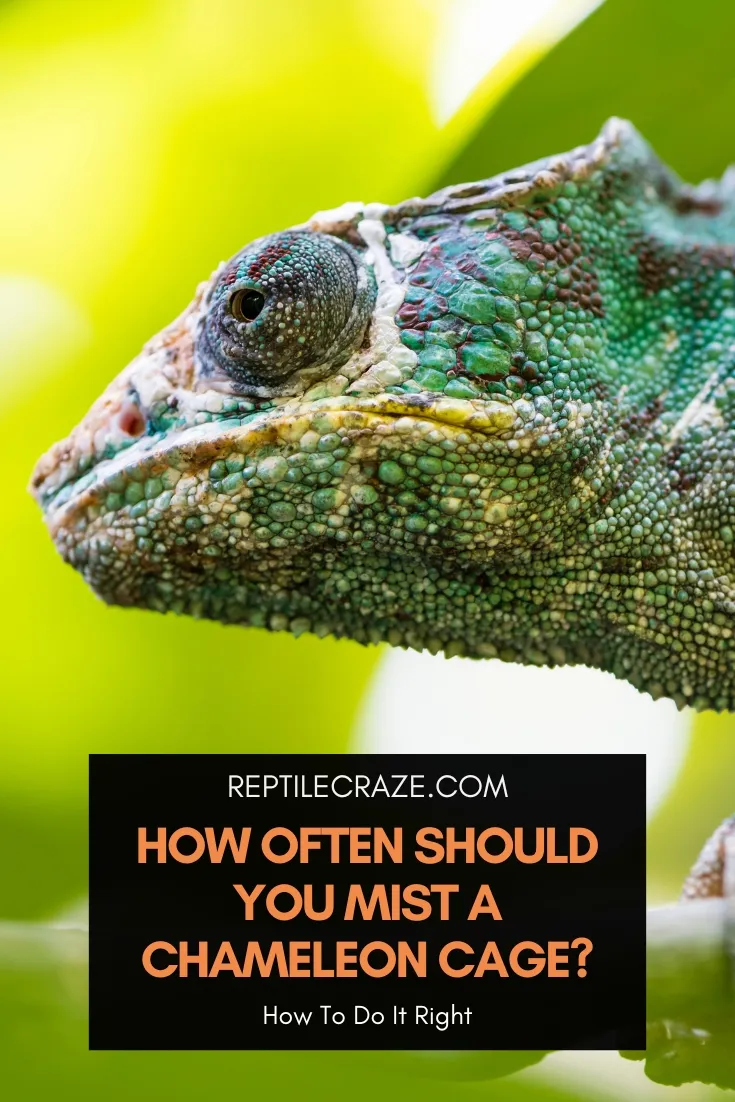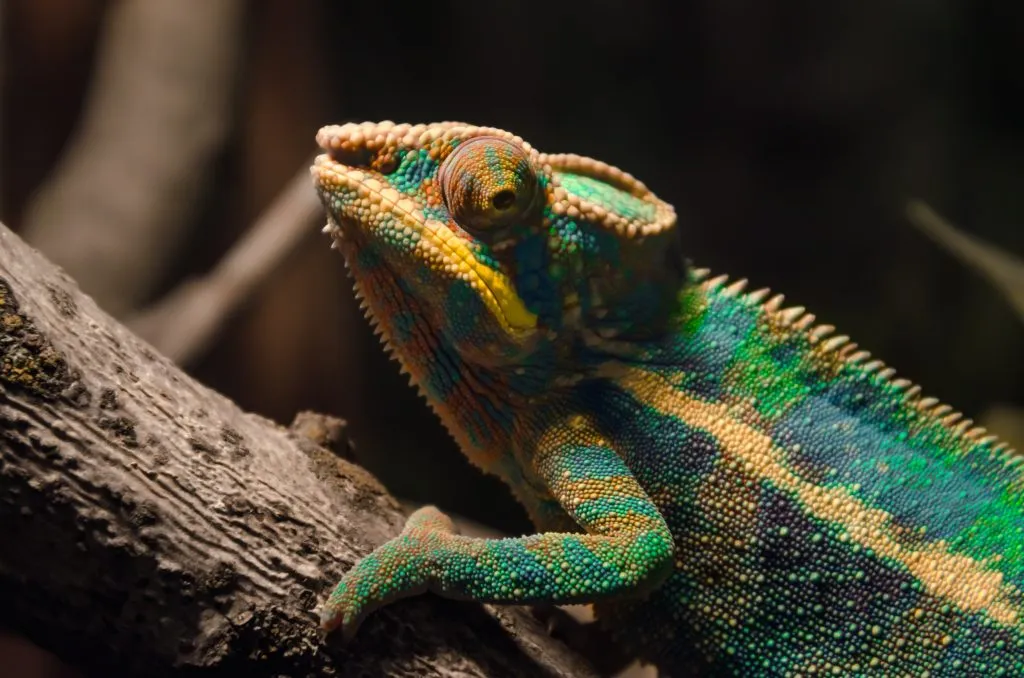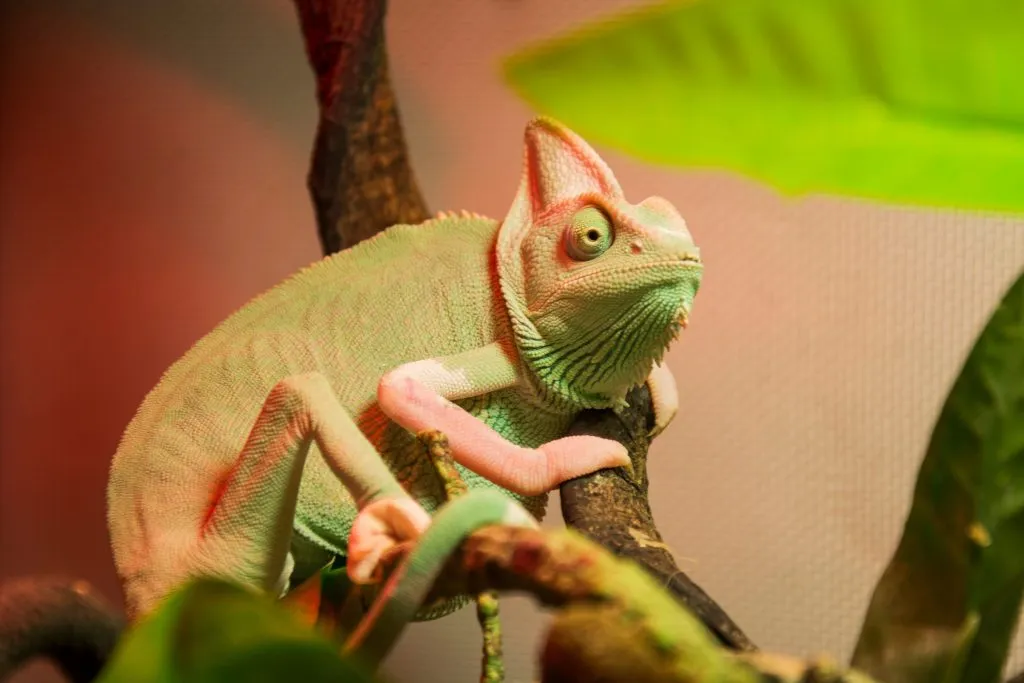
If you’ve currently petting a chameleon, you’re bound to have several questions! One of them might be about how often to mist a chameleon cage. After all, misting is necessary to keep your little pet well-hydrated and in a moist environment.
The misting requirements for a chameleon cage typically depend on the chameleon species and the owner’s environment. As a standard practice, misting the chameleon cage for two to four minutes in the morning and evening is best.
In this guide, we’ve discussed the answers to all your questions related to misting so that you can take the best care of your chameleon!
Table of Contents
How Often to Mist a Chameleon Cage?
You need to mist a chameleon cage, as misting is important for maintaining the cage’s humidity and keeping your chameleon hydrated.
Now, misting a chameleon cage can get tricky. You need to consider various factors and set a misting schedule that works best for your chameleon accordingly.
To give you a general idea, we recommend misting a chameleon
Misting before the lights turn on in the morning can help in imitating morning dew, which can make your little pet feel like they’re in their natural environment!
Then, follow the same schedule in the evening – 30 minutes after you turn off the lights.
Note that the above-mentioned schedule just gives a basic idea. You need to consider more things that can affect the frequency of misting a chameleon cage.
- Chameleon Species – Certain chameleon species have high humidity requirements. Therefore, you need to increase the misting frequency, which can further help in improving the cage’s overall humidity.
- Your Environment – Depending on whether you live in a dry or humid environment, you’ll have to set the misting schedule. Generally, for dry regions, additional misting is required. But, if you live in a naturally humid area, you can tone it down.
Hence, you’ll have to customize and adjust the frequency of misting your chameleon’s cage, as per the above two factors.
How Long Should a Chameleon be Misted?
Along with knowing how often to mist a chameleon cage, you might feel confused about the duration of it. Are you supposed to keep misting the whole cage for 10 minutes or so?
The truth is that most chameleon owners often suggest misting the
Keep in mind that the duration also depends on how often you’re misting the
Misting Frequency for Different Chameleon Species
The table below compares the misting requirements for different chameleon species. As mentioned above, species with higher humidity needs require more frequent misting.
| Species | Humidity Requirements | Misting Frequency |
| Veiled Chameleon | 40% – 50% (day)80% – 100% (night) | 2 – 3 times |
| Panther Chameleon | 50% – 60% (day)75% – 100% (night) | 3 – 4 times |
| Oustalet Chameleon | Around 70% | 3 – 4 times |
| Jackson’s Chameleon | 30% – 50% (day)75% – 100% (night) | 3 – 4 times |
| Flap-Necked Chameleon | Around 50% – 65% | 1 – 2 times |
| Four-Horned Chameleon | Around 80% – 100% | 2 – 3 times |
| Carpet Chameleon | 50% – 60% (day)80% – 100% (night) | 2 – 3 times |
| Pygmy Chameleon | 60% – 80% (day)80% – 100% (night) | 2 times |
How to Mist a Chameleon Cage?

When it comes to misting, keep in mind that you should never directly mist your chameleon. It can startle and stress out your chameleon, causing them to run around. Most chameleons also hate being misted directly.
Hence, you should always focus on misting the chameleon cage. There are three main ways to go about it. Let’s discuss them in detail.
Method 1: Automatic Misting System
The best option to mist your chameleon cage is to go for an automatic misting system. You can purchase an automatic mister and set it up as per the instructions of the specific mister that you’ve bought.
An automatic misting system can mist the whole cage, along with covering the leaves with it. Moreover, you can customize it as per the misting schedule that you want. So, you won’t have to specifically go and mist the
Pros:
- Quick and efficient misting way
- Coms with various features to customize the misting schedule
- Allows uniform misting as per the set schedule
Cons:
- Expensive option compared to others
- Set up may take time
Recommendations:
We recommend opting for the REPTI ZOO Reptile Mister as it offers both variety and functionality. With this product, you get around four nozzles.
You can choose any depending on the cage size. Additionally, it has a large (around 10L) water
If you find the REPTI ZOO mister too expensive, you can opt for MRREPTILE Reptile Mister. It’s practically half the price and comes with two nozzles. Also, it’s easy to assemble and use. Note that over time, it can get a little noisy.
Some other great automatic misters include EXO-TERRA Monsoon Solo Misting System and the old MRREPTILE Automatic Mister for Reptiles.
Method 2: Hand Misters
Using hand misters is the traditional way of misting a chameleon cage. You just need to purchase a hand mister, fill it with water, and mist the
Hand misters are pretty cheap, compared to purchasing an automatic misting machine. Also, you can mist specific areas of the cage to offer better hydration to your chameleon.
However, hand misters can get risky. You need to ensure that you’re thoroughly misting the
Pros:
- Inexpensive
- You can mist as per your requirements
- Allows misting specific areas in the cage
Cons:
- Time-consuming
- Chances of forgetting to mist the
tank
Method 3: Drippers
You can opt for drippers for hydrating your chameleon. Keep in mind that it’s not exactly the same as automatic misters or hand misters. Instead of generating mist, it releases water droplets.
Drippers allow a slow yet consistent flow of water droplets. As chameleons only drink water from moving sources like plants, and not a water bowl, drippers can help. They release water droplets, which fall on the plants and can help hydrate your chameleon.
Also, you can build your own dripper for the chameleon cage, instead of purchasing one.
Pros:
- DIY and a cheap alternative
- Provides a consistent movement of water droplets
Cons:
- Better to use it with a misting machine or hand mist
How to Know If You Have Not Misted the Cage Enough?
You can easily come to know when you’ve not misted your cage enough. Reduced misting can lead to low moisture levels in the cage. It can also cause your chameleon to become dehydrated.
If your chameleon looks dehydrated, then you need to work on the cage’s humidity levels. Some signs of dehydration in chameleons are listed below.
- Sunken or drowsy eyes
- Saggy or loose skin
- Loss of appetite
- Lethargy
- Yellow (mild dehydration) or orange (serious dehydration) urate
Note: The white part in the chameleon’s poop is known as urate. It is typically white but during dehydration, it may become yellow or orange.
If you notice that your chameleon is getting dehydrated, follow the below-mentioned steps to rectify the situation.
- First, increase the misting frequency. If you’re currently misting only twice a day, make it three to four times.
- Invest in an automatic misting system that can ensure uniform misting levels in the cage.
- After increasing misting, add some live plants to the cage. They can help in keeping the cage moist.
- Go for moisture-retaining substrates like coconut husk.
Can You Over Mist Chameleon?

Just like you might not be misting your chameleon’s cage enough, there is a possibility that you might be overdoing it.
When you over mist a chameleon
- High moisture due to over-misting can lead to several problems such as an increase in bacterial growth in the cage as bacteria thrive in moist regions.
- Additionally, the bacteria can enter your chameleon’s body and may lead to respiratory infections. In such cases, your chameleon might face breathing problems, general fatigue, and mucus discharge.
- Tail rot is a common result of high humidity levels and bacterial, or fungal infections. In this condition, the chameleon’s tail tissues die and turn black.
- High humidity can lead to skin infections and pneumonia.
If you feel like you’ve over-misted the cage, you should immediately try to reduce the humidity levels. Some of the common ways include:
- Reduce the frequency of misting. If you were misting two to three times a day, make it once for some time.
- If you’re using substrates like Coconut Husk or Orchid Bark, try changing them. These substrates are excellent at retaining moisture.
- Try to increase the ventilation in the cage by opening any closed areas like the top.
How Long Can a Chameleon Go Without Misting?
Misting is essential to regulate the body functions of a chameleon and to keep them hydrated. Therefore, you need to do it daily by hook or by crook.
Keep in mind that chameleons can only go without misting for about two days. In some extreme cases, they may be able to survive for a week or so.
However, we strongly advise you to mist the cage daily, as not misting for even one or two days can have adverse effects on your pet chameleon.
Frequently Asked Questions
Do chameleons need to be misted at night?
There is no need to mist your chameleon’s cage at night. Instead, you can do it two to three times during the night at intervals of 3 to 4 hours.
Can I mist my chameleon with tap water?
You can or cannot use tap water for misting depending on where you live. Tap water in some places may contain harmful chemicals, like chlorine, that can mess with your chameleon’s system. In such places, the best option is to go for distilled water.
Should I mist my chameleon while shedding?
You can mist your chameleon when they’re shedding as it can improve cage humidity. Also, it is especially helpful if they’re having difficulty removing their shed skin. Just ensure that you don’t directly mist your chameleon, instead mist just the cage.
- Enchi Ball Python: A Unique and Stunning Morph of Python regius - March 27, 2025
- Emerald Tree Monitor: The Enigmatic Green Guardian of the Rainforest - March 26, 2025
- The Egyptian Cobra (Naja haje): A Fascinating Serpent - March 25, 2025
